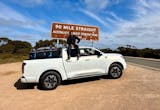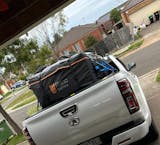
Carbon Offroad Pre-Winch Installation Guide
Please read before installing your Carbon Winch. Not doing so may void your warranty.
This winch installation guide has been provided by Carbon Offroad and is designed as a general guide for the installation of a Carbon Offroad 4x4 winch within a winch compatible bull bar. Depending on your vehicle there may be different variables that impact on how your winch is setup. As such this is a basic guide and may not cover your particular situation.
If you are not confident to perform the below installation we recommend utilising the services of an experienced auto electrician or 4WD service agent to install your winch.
INSTALLATION CHECK LIST
1. Before installing your winch check the battery size in your vehicle. Battery size must be 650CCA or greater to ensure proper and safe operation.
2. Before using your winch the winch rope must be unspooled to the first layer on the drum and wound back on under load. A good way to do this is to connect to a tree with the car in neutral and apply the handbrake slightly and winch in guiding the rope on neatly and evenly. Failure to spool the winch rope on under load before first use will risk damaging the rope and/or crushing the winch drum tube.
3. Make sure all bolts and nuts are firmly secured but not over tensioned on the winch including tiebar and gearbox bolts.
4. Make sure the hammerlock pin is fully inserted into the hook recess using the central retaining ring to keep it in place.
5. Make sure your winch control box black thin earth wire is connected to the earth terminal on the electric motor. This ensures a solid earth point for your solenoid control.
6. Battery terminals which exhibit corrosion or buildup are not suitable to be used as connection points for a Carbon Winch. Replace with new terminals. Ensure that the winch cables are connected directly to the battery terminal, not bunched on top of other accessory wiring.
7. You should never winch more than 20-30 seconds in one pull. The winch and your car battery need time to recover and you should respect the duty cycle of your winch and the health of your battery. Prolonged winching can destroy your battery, winch motor and solenoid.
8. If you can hear the winch struggling to pull your vehicle on a single line pull, use the snatch block provided in the kit to setup a double line pull to have the effort. If the winch still struggles, then you need to evaluate your anchor placement and work on a better line for recovery. Do not continue winching if you can see your vehicle is not making progress during the recovery. Reassess what you are doing and work out a better recovery setup.
9. The wireless remote controls have a fail safe device installed, to operate the wireless remote you must hold down both buttons until the red LED lights up. The remote is now active. The remote will turn itself off after a one minute thirty seconds to conserve battery.
If in doubt or if you have any questions please call Carbon Offroad on 1300 780 141.
CARBON WINCHES MAINTENANCE
Electric 4WD winches are not a maintenance free piece of equipment.
They must have a basic level of inspection and maintenance completed to ensure reliability and longevity, for your own safety and security.
Carbon Winches Australia have made every effort to manufacture the winch to reduce the ingress of water, dirt and dust into the working parts of the motor and gearbox. We have gone to the extra effort of electroplating brush assemblies, winch motor magnets and adding a motor breather kit which are often susceptible to corrosion damage. This extends the corrosion resistance of the winch motor. We currently do not have an IP certification on our winch motors however our testing suggest they meet the standard for IP67.
If your winch is exposed to full or partial immersion it is advisable to winch out the rope fully and then winch in fully to warm up the motor to disperse any moisture and redistribute grease throughout the gearbox to protect the gearsets, after the trip. This simple maintenance technique will go a long way to protecting your winch, and will be all you need to do to ensure that the winch motor internals are dry at the end of a trip. You may decide to do this 2-3 times just to be safe.
We also recommend a yearly maintenance routine to keep your winch in good condition. These maintenance guidelines are not required to be completed to maintain your warranty, but are provided for your own information and guidance in keeping your winch in good condition.
MAINTENANCE GUIDELINES
1. Free spool 20m of rope off the winch and power in under load once a month to heat up the motor and redistribute grease through the gearbox to displace any condensation build up inside.
2. Remove, disassemble and clean all moving parts in the gearbox and regrease lightly (do not pack) with quality high pressure waterproof molybdenum grease at least once every 12 months.
3. After returning from a trip where the winch has been exposed to river crossings, mud, dirt or dust, Be sure to free spool the rope out and power in under load to displace any moisture or condensation inside the winch. Wash the winch with a regular hose and plain water to remove sitting mud, dirt or other debris from the winch housing and the drum area. Do not use a high pressure cleaner on your winch, you risk damaging the sealing units under high pressure.
4. Check conditions of motor terminals and battery cables for wear and tear every 3 months, install protective conduit on wear points to reduce risk of short circuits.
5. Rope which is exposed to dirt, mud and grit will reduce the life of the rope. After exposure, it is good practice spool out the rope, wash with plain water, allow to dry and then respool back on for longevity.
6. In general make sure you check, service and maintain your winch for reliability and the confidence that your winch will be there when you need it most.
7. To maintain your IP warranty you need to replace the drum lip seals every 12 months. This is very easy to do. Simply undo the bolts on the tiebars and remove the gearbox from the drum. Slide the drum off the driveshaft remove the seals on the motor side and the gearbox side, replace with the new seals and reverse the process to complete the seal replacement. Be careful to make sure the driveshaft is correctly engaged with the brake unit on the motor and with the small sun gear on the gearbox side. The urethane drum bushings are also keyed and need to be located in the correct position for the assembly to bolt back in together.



